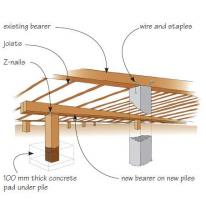Timber floorboards, particleboard or plywood springy
Listed under: Interior, floor coverings, floorboards, timber and wood-based, particleboard, plywood, timber, Subfloor, floors, framing, moisture, durability, borer, rot, leaks
Cause
Span is too great for the size of joists, bearers or flooring
Repair
-
first, determine the actual subfloor framing required, including span dimensions and timber sizes. These can be calculated by an architect, designer or chartered professional engineer
-
options may include adding new joists or blocking, or even adding bearers or piles
-
new subfloor framing timber should be treated to H1.2 and piles to H5
-
if the work involves the foundations (piles, bearers) it falls into the category of ‘restricted building work’. If you are paying a tradesperson to do this, the work must be carried out or supervised by a licensed building practitioner with a Foundations licence
Cause
Joists are cracked or broken
Repair
-
first, determine why joists have cracked or broken. If it is because the subfloor framing is insufficient for the loads, then an appropriate plan should be drawn up to show what support is required. This can be done by an architect, designer or chartered professional engineer
-
options may include adding new joists, completely replacing joists, or fixing a timber plate or metal support to the cracked joists
-
new joists or timber plates fixed to joists as supports should be treated to H1.2
Cause
Floor has been regularly sanded which has reduced thickness
Repair
-
the two main options are to replace the flooring with something stronger and thicker or to provide more support under the flooring with additional joists or blocking. An architect, designer or chartered professional engineer will be able to advise on the latter
-
when replacing flooring in wet areas, ensure that it is sufficiently durable. Sheet flooring in wet areas should be treated to H3
-
additional timber joists or blocking under a floor should be treated to H1.2
Cause
Water damage to flooring or subfloor framing
Repair
-
first, determine the source of the water causing the damage and fix that, whether it is a leak, excessive moisture in the indoor air or a damp subfloor
-
replace the damaged flooring or subfloor framing. If moisture will remain a risk (the flooring is in a bathroom, for example), use durable flooring such as sheet flooring treated to H3. Replacement subfloor framing should be treated to at least H1.2, and timber piles to H5
-
work on foundations (piles, bearers) falls into the category of ‘restricted building work’. If you are paying a tradesperson to do this, the work must be carried out or supervised by a licensed building practitioner with a Foundations licence
Cause
Rotted piles
Repair
-
you can check for rot in timber piles or other timber with a screwdriver. Try to push it into the timber – with timber piles, do this just below the ground surface – and if the screwdriver easily enters the timber, then the timber is rotten
-
all rotten piles should be replaced. Use H5 treated timber piles (or precast concrete piles)
-
replacing just a few old rotten wooden piles under a house with new piles in the same positions does not require building consent (but still needs to comply with the Building Code). More extensive repiling will require a building consent
-
work on foundations falls into the category of ‘restricted building work’. If you are paying a tradesperson to do this, the work must be carried out or supervised by a licensed building practitioner with a Foundations licence
Cause
Borer damage
Repair
-
borer damage to old floorboards is relatively common, especially with untreated or sap timber. If damage is severe and the appearance is unacceptable, replace the flooring. If you want to keep the character of an old villa, look for recycled native timber flooring from a reclamation business
-
if you are not ready yet to replace the flooring but want to treat the infestation, brush or spray infested timber with a residual insecticide, injecting flight holes. Wear a mask and eye protection as the spray may shoot out another hole towards you
-
if the infestation is extensive or you are thinking about fumigation, consult a firm that is a member of the Pest Management Association of New Zealand. Fumigation kills the adults when they are on the wing (approximately November to March)
-
borer damage is more common in damp situations. Ensure the house is well ventilated and the subfloor is dry
Cause
Inadequately supported piles
Repair
-
determine the repair work required for the circumstances. This may involve replacing piles, adding new piles or adding bracing between piles and bearers or joists. An architect, designer or chartered professional engineer will be able to provide guidance
-
replacing just a few old rotten wooden piles under a house with new piles in the same positions, or adding a few additional piles, or adding subfloor bracing, does not require building consent (but still needs to comply with the Building Code). More extensive repiling or building work will require a building consent
-
work on foundations falls into the category of ‘restricted building work’. If you are paying a tradesperson to do this, the work must be carried out or supervised by a licensed building practitioner with a Foundations licence




